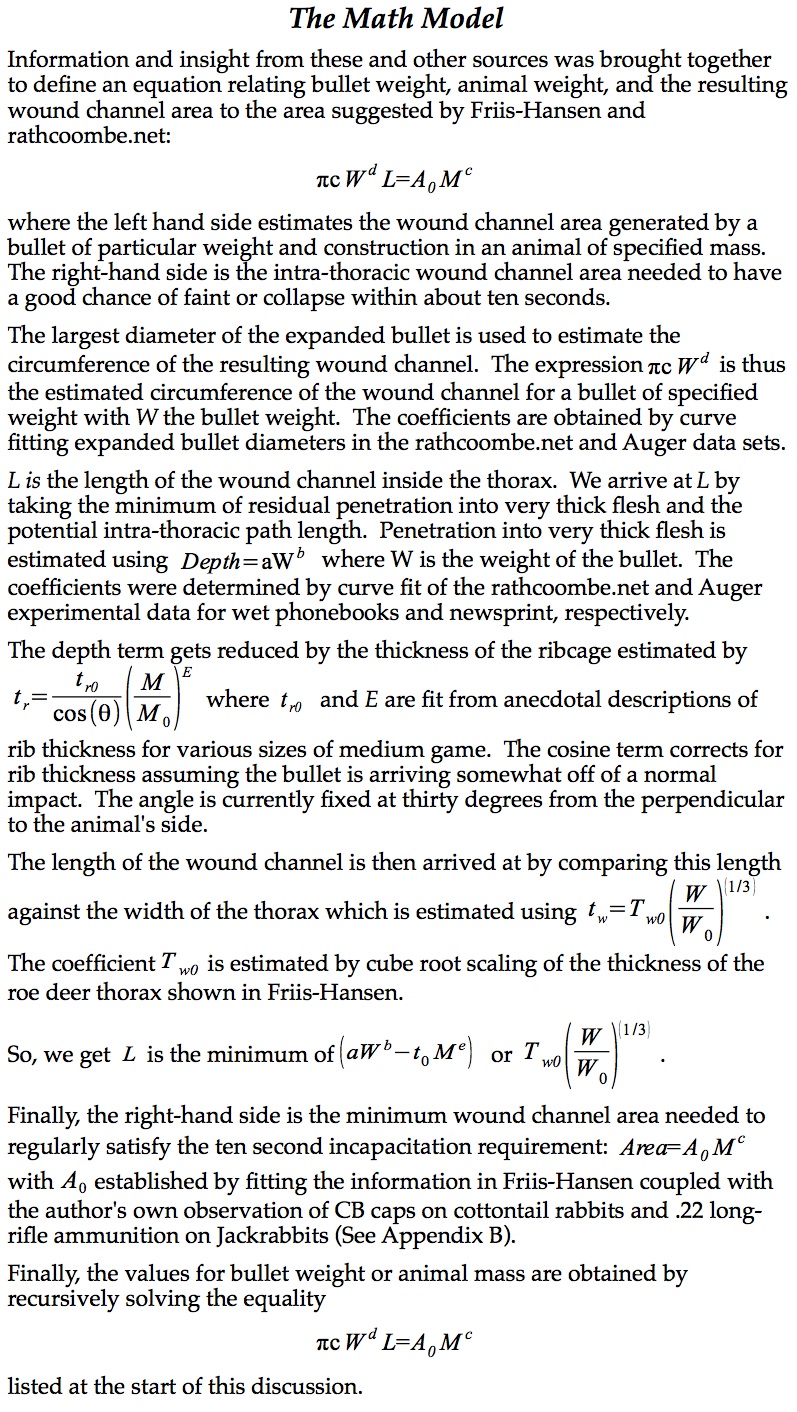Navigation Buttons —
| Ideal Weight | Ideal Weight | The Paper | Appendix A | Appendix B | Appendix C | Appendix D |
|---|---|---|---|---|---|---|
| Imperial Units | Metric Units | Defining Ideal Bullet Weight | Math Model | Min. Wound | Depth and Vel. | Depth and Dia. |
Appendix A. Mathematical Model for Ideal Bullet Weight
In brief, the model used to calculate the recommended bullet weights in the principal discussion is based on the notion that one needs to have a good chance of cause rapid fainting. To do this, we need to create a wound channel in the thorax that is large enough that enough blood channels in the region of the heart are opened to cause a very rapid loss of blood pressure. The critical wound channel area needed to get this probability is described as a function of the animal’s weight. This critical area is compared with the estimated wound channel area caused by a given bullet. The bullet must first pass through the rib cage or other intervening fat, muscle, and bone before doing damage in the thorax. The penetration depth of the bullet inside the thorax is accordingly shortened by this material. It is the area of this truncated wound channel that is compared with the critical channel area.

Figure A-1. It is antlerless season and you have proper license and tags. Where would you aim when this beauty presents her shoulder to you?
Four papers give us the insight summarized above and information needed to calibrate a metric for efficacy of modern hunting bullets:
- Wound ballistics research by Fackleri established the concept that the size of the permanent (vice dynamic) wound channel is an important indicator of effectiveness. Fackler further established that the permanent wound channel is largely formed through cutting and some crushing as the bullet transits the target.
- Archeological research on arrowheadsiimade and used by mesolithic hunters shows that the same principles have governed the evolution of hunting arrows over the past five to ten thousand years. Granted, those ancient arrow makers likely did not have the science underpinning we have today, but they learned what worked over literally thousands of years of trial, error, and observation.
- An interesting paper at rathcoombe.netiii describes several of the currently favored hunting bullet wounding theories and then shows how they fall short of being physically realistic models. He then insightfully uses observations from the first two papers to define a formula describing the relationship between body mass and minimum wound channel area. He also presents an extensive collection of test data including depth and final projectile diameters in experiments using wet phonebooks as the target medium
- Gary Sciuchettiiv did extensive empirical research to demonstrate that wet newsprint (and phonebooks) provide a reasonably good surrogate for flesh penetration. His tests using 180 grain .30 caliber bullets spanning the then-existing range of bullets in this weight and caliber suggest that the penetration depth is largely independent of impact velocity for velocities between 2,000 and 3,000 feet per second. The possible exception is that cup and core bullets tend to have a small fall off at velocities above about 2700 ft/sec while the more modern design premium and bonded bullets maintain the constant penetration to higher velocities.
- Tests conducted by the author of the rathcoombe.net paper using wet phonebooks as well as additional tests by Augerv provided the basis for the empirical relationship between bullet weight and wound channel depth and diameter. Auger tested 6.5 caliber bullets fired into wet newsprint. The Auger data was published in the 24hourcampfire.com forum.

# # # #
i Fackler, M. L., What’s Wrong With the Wound Ballistics Literature and Why, Institute Report No. 239, Letterman Army Institute of Research, Presidio of San Francisco, CA, July, 1987.
ii Friis-Hansen, Jan, “Mesolithic Cutting Arrows: Functional Analysis of Arrows Used in the Hunting of Large Game”, Antiquity, No. 64, 1990, pp. 494 – 504.
iii http://www.rathcoombe.net/sci-tech/ballistics/wounding.html
iv Sciuchetti, Gary, The Best Hunting Bullet, Handloader, No. 193, pp. 40 – 44, June,1998.
v Auger, Steve, Private Communication, May 2013.
Navigation Buttons —
| Ideal Weight | Ideal Weight | The Paper | Appendix A | Appendix B | Appendix C | Appendix D |
|---|---|---|---|---|---|---|
| Imperial Units | Metric Units | Defining Ideal Bullet Weight | Math Model | Min. Wound | Depth and Vel. | Depth and Dia. |

 sending...
sending...